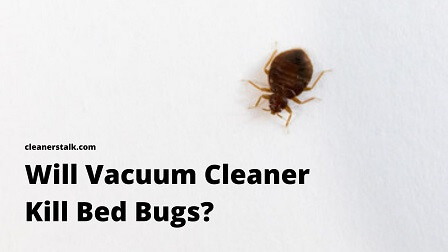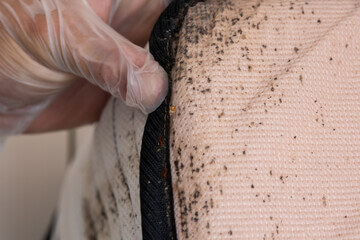
Will Vacuum Cleaner Kill Bed Bugs? (Surprising Answer)
Cleaners Talk is reader-supported. This post contains affiliate links, we may earn a commission at no additional costs to you. As an Amazon Associate we earn from qualifying purchases.
Are you waking up in the morning with itchy skin and have been noticing other curious symptoms, such as reddish-brown spots on your mattresses, bedspreads, and walls?
It is quite possible that you are dealing with a bed bug infestation. With the cost to bring in the local pest control experts expensive, you may wonder will a vacuum cleaner kill bed bugs?
A vacuum cleaner is unlikely to kill all bed bugs in an infestation, as their hard exoskeleton makes it possible for them to survive a trip through the air hose with minimal damage. It is, however, possible to effectively use a vacuum cleaner to help control a bed bug infestation and reduce their numbers.
Although a vacuum cleaner may suffocate some bed bugs, there will undoubtedly be some that survive. This creates the threat of the bed bugs escaping the vacuum bag, reproducing in other areas of the house, and spreading the infestation. So, let’s talk about how to use your vacuum correctly in the fight against bed bugs.
Why a Vacuum Is Unlikely to Kill Bed Bugs

A vacuum cleaner is unlikely to completely solve a bed bug infestation for a couple of reasons.
- It is not possible to see all of the eggs and infant bed bugs with the naked eye. So it is likely that basic vacuuming efforts will be incomplete as these microscopic specimens get overlooked.
- Even for the visible adult bed bugs, their hard exoskeleton makes them tough. They can survive the impact of the vacuum suction that would kill soft-shelled varmints, such as some spiders.
However, despite a vacuum being unable to completely kill off bed bugs by itself, the vacuum is a vital component of any do-it-yourself bed bug control effort.
How to Use a Vacuum in the War Against Bed Bugs
The following process should be used when attempting to kill a bed bug infestation without the help of professional exterminators. A vacuum is only part of this multi-pronged strategy.
1. Reduce Clutter
When they are not feeding on human blood at night, bed bugs like to chill and lay eggs in dark, cool places during the day. So any type of clutter that may shade bed bugs from light, such as old candy wrappers, strewn clothing, or extra pillows or stuffed animals, can be turned into a bed bug refuge.
There are two very important steps to do here:
- Contain. All items should be sealed in a plastic bag before being removed from the room.
- Kill. Once removed, the plastic bags should be given the appropriate hot or cold treatment to ensure that all bed bugs, eggs, and larvae are killed.
It is important when reducing clutter in the wake of a bed bug infestation not to simply throw items haphazardly into another area of the house. This can cause the infestation to spread.
2. Dismantle the Bed
In addition to bedroom clutter, bed bugs find it perfectly suitable to nest down in the bed itself.
This includes not only under the mattress and inside the box spring but inside the crevices of the bed frame’s construction. As a result, it is important to dismantle every inch of the bed frame to give you full accessibility for vacuuming and insecticide treatments.
3. Break Down Furniture
Pull all furniture away from the walls to give you 360° access when cleaning. If you have any desks or dressers that contain drawers, remove the drawers and prepare all sides of the drawers independently, giving you access to the interior of the larger piece of furniture prior to cleaning.
4. Now You Can Vacuum the Area

Now that you have access to the entire surface area of the room, it is time to get to cleaning.
Using a flashlight, closely inspect for any visible signs of bed bugs, whether the bugs themselves or stains from their excrement. If you see signs of bed bugs on hard surfaces, use a stiff brush to scrub the surface and dislodge any eggs that may be embedded.
Thoroughly vacuum every inch of the room. Use the hose attachment to meticulously vacuum:
- Cracks and crevices
- Along baseboards of the walls
- Headboards
- Furniture
- Bed stands
- Rails and footboards
- Edges of the bedding
- Edges of the carpet
Once the room is thoroughly vacuumed, immediately dispose of the vacuum bag. Remove the bag, seal it with tape, and place it in another sealed plastic bag. Take no chances. Dispose of the sealed bag in an exterior trash can or dumpster to prevent bugs or eggs from making their way out.
5. Apply Insecticide Treatment
As mentioned, while vacuuming helps remove bed bugs, it will not kill the bugs in a majority of cases. This is where insecticides come in, as they will kill any remaining bugs, eggs, or larvae in the room.
Some common types of insecticide used in homes include Spectre 2 SC and Crossfire Aerosol (links to Amazon). Be sure to spray every surface, crack, and crevice of the room with the insecticide.
You can also use a non-toxic option like diatomaceous earth, which can be easily vacuumed afterwards.
6. Repeat
Repeat this process three times, once every ten days. Despite your thorough cleaning efforts, even a few surviving bed bugs can cause a renewed proliferation, so it is best to take measures to ensure that your work does not go wasted. Between cleans, check the area for any signs that bed bugs may still be lingering.
The Best Vacuums for Bed Bugs
If your home has been hit with a bed bug infestation, it may be worth your time to invest in a vacuum built specifically with bed bug control in mind. To this effect, the following brands offer some impressive benefits in terms of their functionality in corralling bed bugs:
- SharkNinja Navigator Lift-Away Deluxe NV360 - this product features a push button to easily lift the canister away from the frame, allowing for increased accessibility to hard-to-reach places, such as inside closets or on top of shelves. It also comes with a 5.5-inch crevice tool that will assist in sucking bed bugs out from deep recesses
- Atrix Lil Red Canister HEPA Bed Bug Vacuum AHSC-1 - this is a specially designed canister vac that was meant for easy transportation in the pursuit of bed bugs. It is also compatible with disposable HEPA bags, making it easy to ensure that no bed bugs are nesting in the canister between uses
- Kenmore 81714 Bagged Canister Vacuum - another canister-style vacuum that is highly transportable and features a removable canister bag for the efficient disposal of trapped bed bugs.
If you do purchase a new vacuum to take care of your bed bug problem, make sure to thoroughly clean it after use. You can dispose of the bag, but follow the manufacturer’s directions for cleaning hoses.
Check your product manual to find out if you can submerge the vacuum cleaner hoses. If so, disconnect them and soak them in bleach water to kill any potential bed bug survivors.
PRO TIP: If you want more thorough and comprehensive information on the best vacuum cleaners, then be sure to check out our complete review of the best upright vacuum cleaners. We’ve narrowed it down to the top 5 so you can make well-informed decisions for the overall cleanliness of your home.
Avoid Common Mistakes When Vacuuming Bed Bugs
Although a vacuum is an essential element in ridding your home of bed bugs, improper use can actually cause your bed bug problem to worsen. Therefore, be sure to avoid the following traps when vacuuming bed bugs from your space:
- Do not allow bed bugs to sit in the canister. If your vacuum comes with a disposable liner, throw it out promptly; if it does not, quickly empty the canister into an exterior dumpster and thoroughly clean before the next use. Allowing the vacuum to sit with trapped bed bugs gives survivors the chance to escape and spread to other areas of the house
- Do not be gentle. Bed bugs like to hunker down and cling when they are nesting, so use appropriate force to jar them loose and allow the vacuum to suck them up. If this causes minor cosmetic damage to your room, it is a small price to pay for curtailing the spread of bed bugs
- Do not use bristle attachments. It is best to use the hose itself or hard hose attachments. Eggs can get caught in bristles and never make their way into the canister, causing a new outbreak.
- Don’t use the vacuum again without deep cleaning first. You may want to use a dedicated vacuum cleaner for this job and retire it after this important service. If you do use a new vacuum or one you intend to keep after the job, make sure to thoroughly clean your vacuum, inside and out.
So, can vacuum cleaners kill bed bugs? Yes it can. If you take the proper precautions, you won’t risk making a mistake that spoils the hard work you’ve put into eliminating bed bugs.
Conclusion
Vacuums are unlikely to kill bed bugs, as bed bugs’ hard exoskeletons make them better prepared to handle a trip down a vacuum hose than soft insects. However, while vacuuming itself may not kill bed bugs, it is nonetheless an important element in any DIY bed bug removal process.
By using the advice listed in this article, you can most effectively use a vacuum to help get your bed bug problem under control. Stay clean and don't let the bed bugs bite! 🙂
Related articles:

Ryan O'Connor
I write about house cleaning and vacuum cleaners. For me, nothing is more important than a clean environment to ensure both a healthy and happy life. Learn more.


